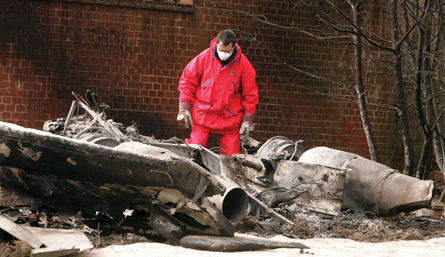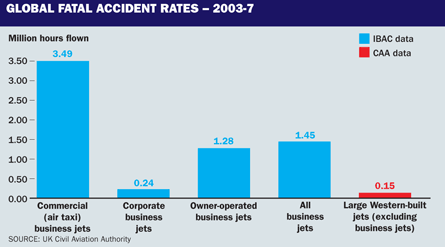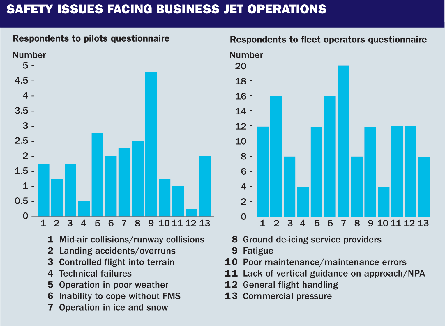Corporate jet operations may be safe, but other business aviation operators appear to be taking an unjustified ride on the corporate sector's good reputation.
That is the conclusion of a highly detailed report into global business aviation safety carried out by the UK Civil Aviation Authority in association with the International Business Aviation Council and the Business Aviation Safety Partnership. This team found that the fatal accident rate for all business jet civil operations is more than eight times that for large Western jets in airline operation, and four times that for large Western-built turboprops flying commercial operations.
The study made a number of recommendations for correcting the situation, but improved pilot training headed the list of priorities.
 |
|---|
© Rex Features |
This is not the kind of self-image business aviation has. And as the sector expands and becomes a higher-profile part of the total global air transport system, the resulting public perception would have a detrimental effect on business. The latter is inevitable unless business aviation improves its safety performance, because industry expansion without improvement would mean a proportionate increase in the number of fatal accidents.
If the industry fails to address safety issues and if, as anticipated, the advent of very light jets significantly expands the air taxi sector, the indicators are that safety figures would be particularly hard hit. The statistical logic at work is that, according to the report, the two parts of the industry whose safety performance drags the rest down are air taxis and owner-flown business jets.
The CAA says the air taxi/ad hoc charter market is worthy of a study in its own right, observing: "The higher overall fatal accident rate for air taxi operations may justify further analysis. European operators are subject to direct regulatory oversight under EU-Ops, the same as for regular public transport, whereas in the USA, air taxi operations are overseen by the less-demanding Part 135 regulations. It is believed the EU-Ops-regulated air taxi operations may demonstrate a far better safety record than the overall [global] figure would suggest. This is a recommended further area for study."
| In 2005 Air Safety Support International, a division of the UK Civil Aviation Authority, commissioned a report from Cranfield University to carry out a risk assessment of international general aviation and corporate aviation. The report revealed that US Federal Aviation Administration Part 135 air taxi operations had the highest risk, and that the corporate sector's relatively high safety performance was due to "the use of up-to-date aircraft, professional pilots and pre-existing company procedures." Recommendations included the introduction of a "no-blame" incident reporting system because there was a reluctance to report errors, and an investigation of the feasibility of introducing flight data monitoring to detect exceedances and incidents. The International Business Aviation Council commissioned a study of accidents between 1998 and 2003 to determine what the effect might have been on the occurrences had the International Standard for Business Aircraft Operations been implemented at that time. The report concluded that between 35% and 55% of the accidents could certainly or probably been prevented by implementation of IS-BAO. |
It is the unfavourable comparison of overall business aviation accident rates with those of the airline industry, combined with rapid growth in business jet operations, that persuaded the CAA the subject deserved serious study. It may not be entirely coincidental that the UK is home to the largest business aviation industry in Europe, but whether it is or not the CAA has always analysed global airline safety, and felt it was time to extend its understanding of operational performance in this growing sector.
The authority says: "Analysis by the UK CAA of worldwide fatal accidents to large jet and turboprop aeroplanes, as described in the CAP 776 Global fatal accident review, revealed that business jets appeared to be involved in a disproportionate number of fatal accidents. The potential for growth in this sector prompted further study, which included an analysis of safety data supplemented by externally contracted research that involved personal industry visits and a questionnaire sent to operators and pilots to obtain feedback on any safety-related issues."
The CAA points out that the study has been endorsed by the Business Aviation Safety Partnership, of which the European Business Aviation Association is a member.
The period under study was the eight years from 2000 to the end of 2007, in which time 59 business jets suffered fatal accidents. The fatal accident rate figures for that period show large jets in airline operation suffered fewer than 0.2 fatal accidents per million hours flown, airline turboprops about 0.8, and business jets 1.7 fatal accidents per million hours flown on all types of civil operation.
The main recommendations emerging from the study covered action required in four arenas: pilot training, regulator interaction, operational issues like crew fatigue, and interaction with air traffic control (see box).
Among business aviation operators using jets during the years 2003-7, figures supplied by the International Business Aviation Council and quoted in the CAA report show that the fatal accident rate for air taxis is 3.49 per million flying hours, for corporate operations it is 0.24, for owner-operated business jets it is 1.28, and the overall figure for all business jets flying civil operations is 1.45 per million flying hours. This tells much the same story as the CAA's own figures for the period 2000-7.
The report presents a breakdown of the 59 fatal accidents under study by the type of operation being performed. This shows that the highest number (21) happened on ferry or positioning flights, 17 occurred on "private/business" flights, six carried cargo, five performed passenger operations, four were air ambulance flights, three were training, and there were three "other" categories.
 |
|---|
The tendency for the risk to be higher during non-revenue flights is an issue the US Federal Aviation Administration has decided to study, because it is a phenomenon that carries across all types of operation, including airlines.
Broken down by phase of flight, the CAA study shows business jet fatal accidents happen most often on approach (19), with landing second at 12. The remainder score as follows: taxi one, take-off eight, climb 11, en-route one, "flight" one, descent four and go-around two.
The primary causal factor in 16 of the 59 fatal accidents under study was "flight handling", according to the CAA, which makes it the most common, but it was also one of several causal factors in a total of 22 of the accidents. The causal factor that was present in more of the mishaps than any other was "omission of action or inappropriate action", which was contributory in 25 accidents (42%), although it was the primary cause in only nine. To summarise, the top five primary causal factors were flight handling (16 accidents/27%), lack of positional awareness (11/19%), omission of action or inappropriate action (nine/15%), poor professional judgement/airmanship (four/7%) and disorientation or visual illusion (two/3%).
As for circumstantial factors, poor visibility or lack of external visual reference was the most common, present in 21 accidents (36%).
A major part of the CAA report consisted of an analysis of the responses to questions sent by the CAA to pilots, operators and training organisations operating in the sector based in the UK. The main points that came out of the survey was that while pilots use simulation for their type rating training, most pilots do not have access to simulation for recurrent training, because for some types there is no such simulation available in the UK.
A high proportion said that pre-course distance learning material was inadequate, and did not prepare them for type training. Respondents also said that many employers did not provide their crews with sufficient training to cope with unfamiliar destinations or those with unusual characteristics, despite the fact that business jet pilots are more often exposed to new or occasionally used destinations than airline pilots.
Finally, business jet pilots, particularly those who operate single-pilot flights, say that fatigue can be a problem because their crew duty frequently includes far more pre-flight preparation and post-flight management than airline operations do, extending their crew duty time well beyond what an airline pilot would experience for a flight of a given length. They also remark that little or no "whole task" training is offered despite the fact that this is a natural characteristic of business aviation flying.
|
|---|
RECOMMENDED SAFETY IMPROVEMENTS
Business aviation operators needs to address "the limited ability of pilots to conduct safe flight without a serviceable flight management system". Although they are familiar with using automation, says the UK Civil Aviation Authority, business jet pilots demonstrate "incomplete understanding or variable ability in areas such as the use of auto-flight modes, particularly in relation to vertical guidance, energy management and poor weather operations".
Lack of access to training in simulators - particularly for recurrent training - is cited as a problem that affects a large proportion of business jet pilots in the global industry. So when training takes place it is frequently in the aircraft itself, which - for safety reasons - limits the kind of exercises that can be flown. The study recommends:
The investigation of low-cost simulation options so that recurrent training can be carried out in simulators.
The need to keep proper training performance records for the pilot workforce and to analyse pooled performance records for indicators of what, in the training system, needs improvement.
Despite the unique nature of business jet pilots' jobs - particularly when they are away from base at remote locations - they receive little or no company training in managing "additional duties", the CAA observes.
These include the expectation that pilots will often help clients with non-flying arrangements for the trip under the total service concept that business aviation embraces, and there is a need to liaise with airfield staff at remote locations for the care of the aircraft. If there is no preparation for any of this, says the CAA, the crew can be dangerously distracted from their primary tasks of flying the aircraft and managing the flight as a safe operation. The report recommends:
Major pilot training organisations should be informed of pilot feedback on "whole task" training and any pre-course training materials.
REGULATOR INTERACTION
The report notes that operators perceive a lack of interest in business aviation by regulators, and often find it difficult to establish who their contacts should be at their national agency. In Europe, the business aviation community says it feels ill-informed about changes promulgated by the European Aviation Safety Agency and the Joint Aviation Authorities. The report recommends this should be addressed, and suggests an information leaflet summarising issues specific to business aviation, and providing contacts.
OPERATIONAL ISSUES
Pressing issues, says the report, spread across the gamut of operations. They include flightcrew fatigue, commercial pressure - particularly, it notes, in air taxi operations, de-icing service providers, standard operating procedures in small operators (lack of guidance), runway length and performance issues, runway contamination, and a poor reporting culture.
The recommendations are equally comprehensive:
- Make the system for aircrew fatigue evaluation software model available to business jet operators "to raise awareness of flightcrew fatigue issues".
- For improving standard operating procedures, operators should adopt the IS-BAO (international standard, business aircraft operations).
- Inform operators of web-based training materials for crew knowledge-related issues, like operations in ice and snow.
AIR TRAFFIC CONTROL
Pilots report a lack of air traffic control centre appreciation of business jet performance, particularly climb and descent rates and their relationship to speed restrictions, says the study. UK air navigation service provider NATS data shows that business jets feature in a disproportionately large number of level busts, lateral non-compliance events and runway incursions. The report recommends the business aviation industry should work with air navigation service providers to:
- Make the performance characteristics of this group of aircraft better known to controllers.
- Recognise the impact on workload during single-pilot operations of changes to clearances or other instructions.
- Minimise the number of radio transmissions and frequency changes during critical phases of flight.
All the latest news from EBACE
Source: Flight Daily News














